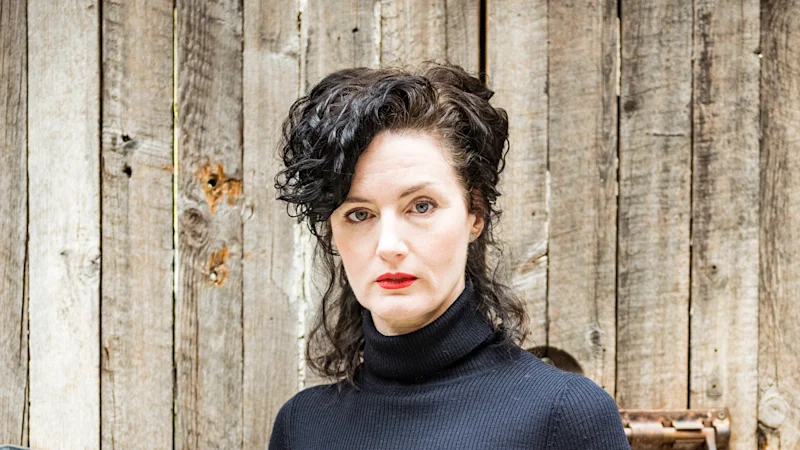
Normal text sizeLarger text sizeVery large text size
When actor Emma Louise Pursey set out to write a play about artist Joy Hester, she could hardly have imagined that it would take more than two decades to finish the work and that her life would parallel Hester’s in troubling ways.
In her mid-20s and living in Brisbane, Pursey had not even heard of Hester, a bold, bawdy, peroxide blonde who fought against gender stereotypes, and a domineering mother, to carve a place for herself among “the boys” of Melbourne’s modernist art scene.
Hester belonged to the famed Heide Circle, named for the farmhouse on the outskirts of Melbourne where patrons John and Sunday Reed nurtured artists including Sidney Nolan, John Perceval and Albert Tucker.
“I was keen to cut my teeth on my first solo show, which is always a rite of passage for actors,” Pursey says when we meet in Collingwood on a sunny spring day. “I knew I wanted to do a solo show on a woman in history, an Australian woman preferably, and my friend Amy Hyslop, who was fresh out of a University of Queensland art history degree, said, ‘Emma, read this’, and she put Joy Hester in my hand, the definitive biography by Janine Burke, and said, ‘I think you will love Joy’.”
Pursey immediately identified with Hester’s unconventional nature, her interest in the avant-garde, and her desire to be an artist, despite the obstacles for women of her time. Hester’s brief life – she died in 1960, aged 40 – was tempestuous, tragic and inspirational. Pursey had found her subject.
At one point Pursey wondered if her subject was toying with her from beyond the grave.Credit: Chris Hopkins
She researched all she could about Hester, devouring Burke’s biography and her follow-up, Dear Sun, a collection of letters between Hester and Sunday Reed, as well as combing through library archives and reading other texts on Hester and her peers. With the help of Arts Queensland funding, Pursey and Hyslop co-wrote the first iteration of Where Is Joy? The title alludes to Hester’s lack of recognition during her lifetime, and even to this day.
After performing the work at Brisbane’s Metro Arts theatre in November 2004, Pursey was encouraged to apply for a second round of development funding. But the project came to a grinding halt when, in December 2004, she was diagnosed with Hodgkin’s lymphoma.
“I was 27, the same age as Joy when she was diagnosed with Hodgkin’s lymphoma,” Pursey says. She thought “what the f—, Joy, are you trying to kill me?”
Hester was fascinated with the occult, claimed to see poltergeists, and kept a crystal ball in which she divined her own death. Not too far a leap, then, for Pursey to think that the mischievous artist was toying with her from beyond the grave.
Loading
Three days after Pursey’s diagnosis, she learnt that the lump under her left eye was in fact amyloidosis, a rare and incurable disease that can be mistaken for Hodgkin’s. In early 2005, she had surgery to reduce the lump. Several months later she met and fell in love with singer-songwriter Grant McLennan, the co-founder of famed Brisbane band the Go-Betweens.
“We were so happy, and then he and I had a housewarming and engagement party and it was on that day that he died from a heart attack,” Pursey says. “Guests started arriving, and we had to say, ‘I’m sorry, he’s not here any more’.”
McLennan died in 2006, aged 48. Amid profound grief and ongoing health concerns, Pursey set aside her play about Hester. “I just had to step away from the project,” she says. Eventually, she stepped away from Brisbane too, moving to Melbourne.
“I just knew I had to leave, there were too many memories and it was too painful,” she says. The Hester project was reignited in January 2023, when Pursey was incensed by the scant mention made of the artist in the play Sunday, based on Sunday Reed’s life.
“In a three-hour play there was about a five-minute scene with Joy Hester … She was a footnote. I left the theatre in a rage … I said to Joy, ‘Not on my watch, it’s time to finish what I began all those years ago’.”
“In a three-hour play there was about a five-minute scene with Joy Hester … I said to Joy, ‘Not on my watch, it’s time to finish what I began all those years ago’.”
Emma Louise Pursey
Pursey and I are sitting in the tranquil, walled courtyard of the studio where she is about to begin rehearsing. Now aged 48, she’s wearing mannish jeans with cuffed hems, a shirt and jumper, loafers and thick socks, emulating Hester’s look from a 1959 photograph of the artist just before she died. It’s the photo that Pursey looks to for inspiration.
“I’m not the floral ’40s Joy in this show,” Pursey says. “This is not the Joy that you would immediately recognise represented by the photos and paintings of Albert Tucker, who would not let her escape the confines of that ’40s Joy, the blonde bombshell.”
Hester met Tucker, five years her senior, when she was 17. They married in 1941, when Hester was 20. At age 27, ill with Hodgkin’s disease, she left Tucker and her two-year-old son, Sweeney, to live in Sydney with the artist Gray Smith, with whom she’d been having an affair.
If today’s world continues to be unsettled by smart, daring, artistic and sexually adventurous women, it was triply so during Hester’s time; even John Reed called her a “hoyden”. Sunday, however, was Hester’s constant ally. She was also her lover, as art historians Lesley Harding and Kendrah Morgan revealed in their 2015 book, Modern Love: The Lives of John & Sunday Reed.
Pursey has framed Where Is Joy? from the perspective of a dying or perhaps already dead woman, recalling in flashback the significant episodes of her life, from unwanted pregnancies to the shock of being diagnosed with a terminal illness and the difficulties of making it as a female artist. Pursey captures Hester’s voice in a monologue that is funny, earthy, vulgar and poignant, and adopts a poetic rhythm (Hester wrote poetry as well as making art).
Albert Tucker’s photograph, Arvo Tea: Sidney Nolan, Sunday Reed and Joy Hester (1945).Credit: Heide Museum of Modern Art
While Sunday Reed recognised and encouraged Hester’s talent, others dismissed it. At Hester’s first solo exhibition in February 1950, not a single work sold. Critics dubbed her work obscure and amateurish, and reactions to her later exhibitions remained lukewarm. It didn’t help that Hester drew rather than painted, partly because she couldn’t afford paint. But also because she loved the spontaneity of drawing, working rapidly, using ink, watercolour, gouache, charcoal, pen and pencil, to create images of shocking intensity. Eyes feature emphatically – protruding, bulbous, deranged, troubled, love-struck, soulful.
“Joy Hester was really ahead of her time, and I think that’s why her work speaks to a contemporary audience,” says Kendrah Morgan, the head curator at the Heide Museum of Modern Art. “Drawing is now considered an autonomous medium in its own right and we celebrate it. But when Hester was creating her drawings, it was considered inferior to painting. That’s one of the reasons she didn’t receive the recognition. But at the same time, I kind of think that probably afforded her a bit of creative freedom, because she realised she wasn’t going to be commercially successful, so she may as well do what she liked.”
Pursey gave a reading of Where Is Joy? at the Heide library in March last year, performing it in front of the very fireplace where Hester would sit drawing.
“It was so powerful,” says Morgan. “Emma has kind of lived and breathed this because she really identifies with Hester.”
Director Susie Dee and Pursey during a break in rehearsals.Credit: Chris Hopkins
Where Is Joy? is directed by Susie Dee, best known for the works she has staged with playwright Patricia Cornelius, which often feature women on the margins – bad, irredeemable, out-of-control women.
“Yeah, well, Joy’s bad!” Dee says. “People who know her work and what she had gone through have very strong opinions of her. Some people put her on a pedestal, the feminist artist that was never given enough credit, and then other people judge her harshly. Leaving her child was a big thing as a woman in that era. But I hope they take away [from this production], wow, what an incredible artist, what an incredible, bold, feminist. She was courageous in her art, her personal life, her politics, her compassion.”
Where Is Joy? is at fortyfivedownstairs, October 30-November 9.
Find out the next TV, streaming series and movies to add to your must-sees. Get The Watchlist delivered every Thursday.





